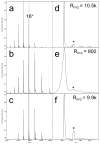Development and Evaluation of a Reverse-Entry Ion Source Orbitrap Mass Spectrometer
- PMID: 29796735
- PMCID: PMC6251776
- DOI: 10.1007/s13361-018-1976-0
Development and Evaluation of a Reverse-Entry Ion Source Orbitrap Mass Spectrometer
Erratum in
-
Correction to: JASMS, Volume 30, Number 1, January 2019.J Am Soc Mass Spectrom. 2019 Mar 1;30(3):561. J Am Soc Mass Spectrom. 2019. PMID: 31922744
Abstract
As a step towards development of a high-resolution ion mobility mass spectrometer using the orbitrap mass analyzer platform, we describe herein a novel reverse-entry ion source (REIS) coupled to the higher-energy C-trap dissociation (HCD) cell of an orbitrap mass spectrometer with extended mass range. Development of the REIS is a first step in the development of a drift tube ion mobility-orbitrap MS. The REIS approach retains the functionality of the commercial instrument ion source which permits the uninterrupted use of the instrument during development as well as performance comparisons between the two ion sources. Ubiquitin (8.5 kDa) and lipid binding to the ammonia transport channel (AmtB, 126 kDa) protein complex were used as model soluble and membrane proteins, respectively, to evaluate the performance of the REIS instrument. Mass resolution obtained with the REIS is comparable to that obtained using the commercial ion source. The charge state distributions for ubiquitin and AmtB obtained on the REIS are in agreement with previous studies which suggests that the REIS-orbitrap EMR retains native structure in the gas phase. Graphical Abstract ᅟ.
Keywords: Exactive; Instrument development; Ion source; Membrane protein; Orbitrap.
Figures





Similar articles
-
Fourier Transform-Ion Mobility-Orbitrap Mass Spectrometer: A Next-Generation Instrument for Native Mass Spectrometry.Anal Chem. 2018 Sep 4;90(17):10472-10478. doi: 10.1021/acs.analchem.8b02463. Epub 2018 Aug 22. Anal Chem. 2018. PMID: 30091588 Free PMC article.
-
Separation of biologically relevant isomers on an Orbitrap mass spectrometer using high-resolution drift tube ion mobility and varied drift gas mixtures.Rapid Commun Mass Spectrom. 2019 Jul;33 Suppl 2:3-10. doi: 10.1002/rcm.8414. Epub 2019 Apr 10. Rapid Commun Mass Spectrom. 2019. PMID: 30772932
-
New High Resolution Ion Mobility Mass Spectrometer Capable of Measurements of Collision Cross Sections from 150 to 520 K.Anal Chem. 2016 Oct 4;88(19):9469-9478. doi: 10.1021/acs.analchem.6b01812. Epub 2016 Sep 15. Anal Chem. 2016. PMID: 27573618
-
Native IM-Orbitrap MS: Resolving What Was Hidden.Trends Analyt Chem. 2020 Mar;124:115533. doi: 10.1016/j.trac.2019.05.035. Epub 2019 May 31. Trends Analyt Chem. 2020. PMID: 32189816 Free PMC article.
-
Orbitrap mass spectrometry: instrumentation, ion motion and applications.Mass Spectrom Rev. 2008 Nov-Dec;27(6):661-99. doi: 10.1002/mas.20186. Mass Spectrom Rev. 2008. PMID: 18683895 Review.
Cited by
-
Generation of Charge-Reduced Ions of Membrane Protein Complexes for Native Ion Mobility Mass Spectrometry Studies.J Am Soc Mass Spectrom. 2019 May;30(5):886-892. doi: 10.1007/s13361-019-02187-6. Epub 2019 Mar 18. J Am Soc Mass Spectrom. 2019. PMID: 30887461 Free PMC article.
-
Optimization of a Digital Mass Filter for the Isolation of Intact Protein Complexes in Stability Zone 1,1.Anal Chem. 2023 Feb 7;95(5):3062-3068. doi: 10.1021/acs.analchem.2c05221. Epub 2023 Jan 26. Anal Chem. 2023. PMID: 36701646 Free PMC article.
-
Variable-Temperature Electrospray Ionization for Temperature-Dependent Folding/Refolding Reactions of Proteins and Ligand Binding.Anal Chem. 2021 May 11;93(18):6924-6931. doi: 10.1021/acs.analchem.1c00870. Epub 2021 Apr 27. Anal Chem. 2021. PMID: 33904705 Free PMC article.
-
Selective binding of a toxin and phosphatidylinositides to a mammalian potassium channel.Nat Commun. 2019 Mar 22;10(1):1352. doi: 10.1038/s41467-019-09333-4. Nat Commun. 2019. PMID: 30902995 Free PMC article.
-
Fourier Transform-Ion Mobility-Orbitrap Mass Spectrometer: A Next-Generation Instrument for Native Mass Spectrometry.Anal Chem. 2018 Sep 4;90(17):10472-10478. doi: 10.1021/acs.analchem.8b02463. Epub 2018 Aug 22. Anal Chem. 2018. PMID: 30091588 Free PMC article.
References
-
- Lanucara F, Holman SW, Gray CJ, Eyers CE. The power of ion mobility-mass spectrometry for structural characterization and the study of conformational dynamics. Nat Chem. 2014;6:281–294. - PubMed
-
- von Helden G, Wyttenbach T, Bowers MT. Inclusion of a MALDI ion source in the ion chromatography technique: conformational information on polymer and biomolecular ions. Int J Mass Spectrom Ion Process. 1995;146–147:349–364.
-
- Wittmer D, Chen YH, Luckenbill BK, Hill HH. Electrospray Ionization Ion Mobility Spectrometry. Anal Chem. 1994;66:2348–2355.
-
- Jurneczko E, Barran PE. How useful is ion mobility mass spectrometry for structural biology? The relationship between protein crystal structures and their collision cross sections in the gas phase. Analyst. 2011;136:20–28. - PubMed
Grants and funding
LinkOut - more resources
Full Text Sources
Other Literature Sources
Research Materials

